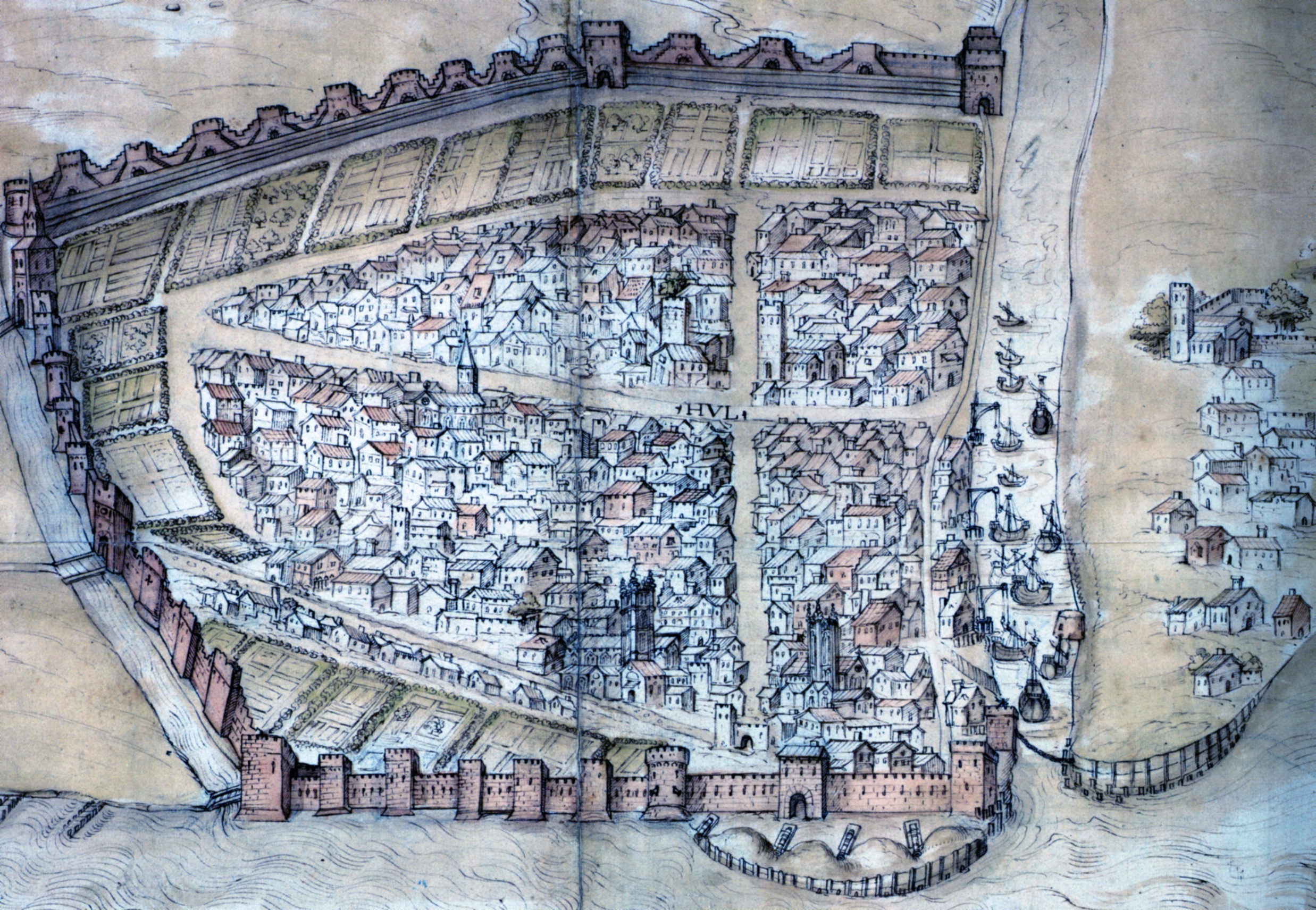In 1299 Kings Town was granted borough status by King Edward I. The old town faced the river Hull, not the Humber. In the 1330s King Edward II licensed the ditch and wall using 5 million bricks with 30 towers and 4 gates. The walls lasted 400 years but were demolished in the early 19th century for expansion of the docks. The bricks were made in Hull making it one of the earliest documented brickworks in England.
Two fine medieval churches still exist in the old town, these being Holy Trinity, built from 1300, and St Mary's, built from 1327. Holy Trinity was possibly the largest parish church in the country and employed royal masons. Carved angels feature throughout and leopards, that allude to the rich 'de la Poles' merchant family.
The medieval prosperity of Hull was based on the export of wool to Europe along with cloth and lead. Imports included timber, corn, flax, cod, herring, iron and wine. Hull was second to London for this trade with the Hanseatic League, Holland & Belgium, along with Baltic ports. Many medieval timber framed buildings still survive in the old town today.
In the 16th century, Henry VII built new defences to the east of the river Hull. Hull castle became a principle store of arms and ammunition along with the Tower of London. The town was heavily involved in the civil war, siding with the parliamentarians.
In the 17th century the trade with the Dutch influenced many new buildings. From the mid 18th century Hull became Britain's fastest growing port exporting products of the industrial revolution from mills and factories in Yorkshire, Lancashire and the Midlands. In the Georgian era, Blaydes House was built in 1750. This merchant family also built ships. Blaydes House is now home to the University of Hull's Maritime History Centre and archive.
Other great noteworthy buildings are Charterhouse, Pease Warehouses, Old Dock Office, George Street, Trinity House, Wilberforce House, City Hall, Guildhall & Law Courts.
In 1774 the Hull Dock Company was established and 4 years later Queen's Dock was opened covering 11 acres, the largest inland dock in Britain. It was filled in in 1930 and is now Queen's Gardens. In the 19th century other docks were built, one is now the marina. The old Humber Dock Tavern has green glazed bricks and overlooks the old Spurn Lightship. The soil from the Humber Dock was used to reclaim land, now the fruit market area and wonderful Minerva pub.
At the beginning of the 19th century, Hull's maritime links via the river Humber, Trent & Ouse were put under pressure by the railway arriving in 1840. The city played a major role in the migration of Europeans to America during the later part of the 19th century. Hundreds of thousands from Scandanavia and Russia passed though Hull heading to Liverpool docks.
In 1860 Charles & Arthur Wilson took over and built up the Wilson Line steamship company, the largest independent one in the world. They built what is now the maritime musuem. The new Victoria Dock was opened in 1850 to the east of the town and is now mostly housing. The western docks were built when the 'silver pits' fishing grounds were discovered, 30 miles east of Spurn point. Albert Dock opened in 1869 and Hessle Road became the heart of the fishing community. 7000 fishing boat trips were made each year. In 1883 the fish market was opened on St Andrew's Dock but sadly deep sea fishing in arctic waters ended in the 1970s. The old docks are now silted up and abandoned.
Hull has a fine collection of pubs including the Punch Hotel, Empress Hotel, White Hart, Polar Bear, Olde Black boy and Olde Blue Bell. Hull suffered more bomb damage in WWII than any other urban area outisde London. There were 86 raids from 1940 to 1945. 1200 people died and 152,000 made homeless, 86,000 homes were damaged. Half the city centre shops were lost and 30 churches and chaples damaged.
The Humber Bridge opened in 1981 and then shopping centres and housing were built in some of the old docks. The aquarium, The Deep, was opened in 2002 and the Hull History Centre in 2009. In 2012 the old Alexandra Dock was made into an assembly area for offshore windfarm turbines. Hull still maintains its unique cream coloured street telephone boxes, run by Kingston Communications. In 2017 Hull was the UK City of Culture. For more information see https://www.visithull.org
